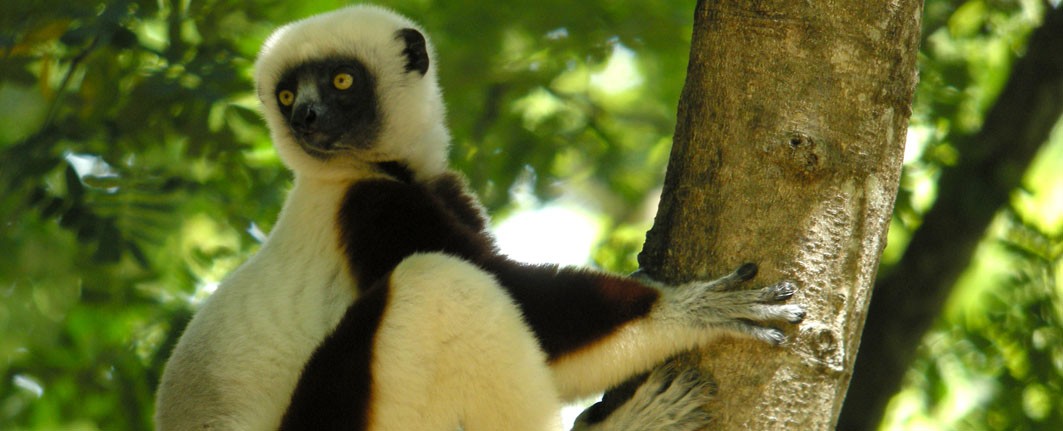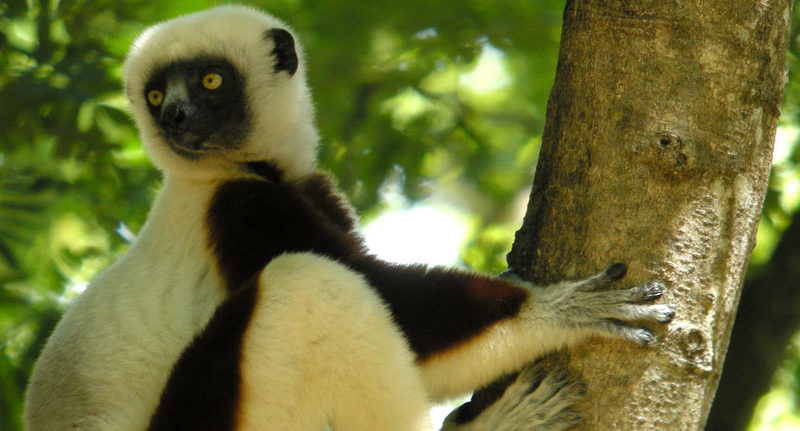
Madagascar Coquerel’s Sifaka: Madagascar’s Iconic Leaping Lemur
Madagascar is home to an extraordinary array of lemurs, but among them, the Madagascar Coquerel’s Sifaka stands out for its distinctive appearance, remarkable agility, and charismatic behavior. Observing this lemur in its natural habitat is a highlight for wildlife enthusiasts and a must for any Madagascar wildlife tour.
What is Madagascar Coquerel’s Sifaka?
The Madagascar Coquerel’s Sifaka is one of Madagascar’s most recognized lemur species. Known for its large size, chestnut, black, and white fur, this lemur is easily distinguished from other sifakas. Its explosive “see-fak” vocalization alerts visitors to its presence, making sightings even more thrilling.
Physical Appearance and Identification
It is a large lemur with striking coloration. Its rich chestnut body contrasted by black limbs and a white tail make it instantly recognizable. Adults typically live in groups ranging from 3 to 10 individuals, providing a social dynamic that fascinates primatologists and tourists alike.
Distribution and Habitat of Madagascar Coquerel’s Sifaka
This Sifaka primarily inhabits the dry forests of northwest Madagascar. Unlike their eastern rainforest relatives, these sifakas are adapted to more open, arid environments. Their distribution is relatively limited, making protected areas like Ankarafantsika National Park the best place to encounter them.
Dry Forest Adaptations
In dry forests, it tends to live at lower densities and have larger home ranges compared to other sifaka species. Their social groups are smaller, yet they maintain complex interactions, showcasing fascinating lemur behaviors such as coordinated foraging and grooming.
Behavior and Diet
The Madagascar Coquerel’s Sifaka exhibits behavior typical of sifakas but with some unique adaptations for its habitat. These lemurs primarily feed on leaves, fruits, flowers, and seeds. Their diet is similar to other sifaka species, yet they can adjust to seasonal variations in dry forests.
Social Structure and Reproduction
Groups usually consist of 3 to 10 members, with a single young born between June and July. The family unit is tight-knit, and members often display coordinated movement through leaping and climbing—a behavior that makes them so captivating to observe.
Where to See Madagascar Coquerel’s Sifaka
One of the best places to spot the Sifaka is Ankarafantsika National Park, especially around the park headquarters. Here, visitors can enjoy repeated sightings of this iconic lemur in its natural environment, offering perfect opportunities for photography and wildlife observation.
Tips for Wildlife Watching
-
Early Morning Visits: Madagascar Coquerel’s Sifaka are most active in the morning.
-
Quiet Observation: Approach slowly to avoid startling the lemurs.
-
Guided Tours: Hiring a local guide increases the chance of spotting them and learning about their behavior.
Why Madagascar Coquerel’s Sifaka is Special
The Madagascar Coquerel’s Sifaka is not just another lemur. Its elegance, incredible leaping abilities, and engaging social interactions make it a symbol of Madagascar’s unique biodiversity. Conservation efforts in dry forests are crucial to protect this species from habitat loss and ensure future generations can witness their charm.
HT AGENCY TOURS
Luxury Madagascar with the best luxury African safari tours packages. Discover your next perfect destination with HT Agency Tours

